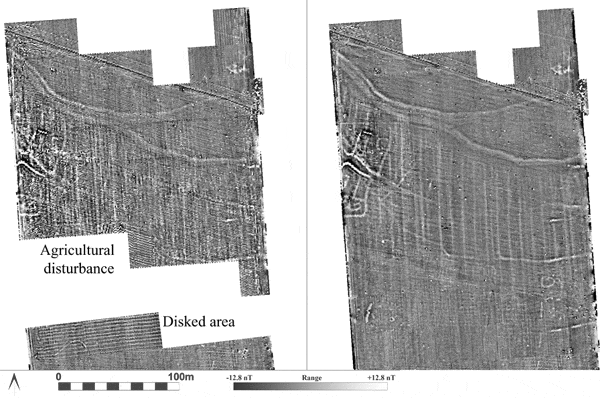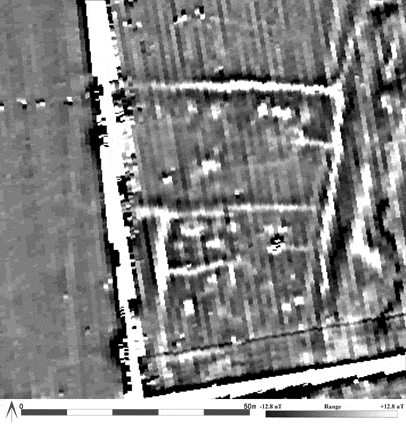Multi-Spectral Imagery
LRC Project EH3841
Magnetometry: When magnetic techniques give poor results
As part of our research strategy, we have set up a number of reference sites, for two important reasons. The first is that we can test the data from new instruments against a known return, and the second is that we can test the same instruments as the field undergoes different agricultural processes, allowing us to determine the best field conditions for different instruments.
Although magnetic prospection is one of the few geophysical techniques where you can expect to get a the same return no matter which time of year you carry out the survey, there are exceptions to this rule. If the overlying ploughsoil has a higher magnetic susceptibility the the difference between the subsoil and the material filling the cut features, they will be difficult to detect. If you carry out a magnetic survey immediately after ploughing, as well as bring exceptionally difficult to walk on, many subtle archaeological anomalies will be masked by the effect of the recently disturbed ploughsoil.
Some agricultural practices, such as disking, have a substantial effect on the data collected, but apparently only for a relatively short period of time. The implications for the timing of gradiometer surveys are demonstrated below, which shows the same field (site 037) re-surveyed under different agricultural conditions.
 |
The data displayed on the upper part of the image on the left was collected in February 2002, when the northern area of the field was covered in straw and carrots, both of which had been partially turned into the surface. In addition, a number of deep ruts were present across the area. In late April 2002, while the southern part of the site was being surveyed, the central area was disked, and four grids were surveyed immediately after the machine had finished the disking. The east-west anomalies caused by the disking are clearly visible. The data on the right is from a second survey of the same field in October 2002, when it was under a turf crop. The change in data clarity is remarkable, with a number of archaeological anomalies now clearly defined. Also of note is the complete absence of any evidence for the disking. The ramifications for magnetic surveying are clear; that surveying using this method should not be carried out immediately after ploughing or any other intrusive agricultural practice, as time should be allowed for the soil to “settle” before attempting magnetic surveying. The exact time required for this “settling” needs to be assessed, which could be done by returning to an area affected by disking, and resurveying the same area on a weekly (or even daily) basis until the effects were gone, although the time taken for the effects to dissipate could well vary depending on soil composition.
The image below shows an enclosure system spread across two modern fields. The field on the left is a horse paddock under permanent pasture, whereas the field on the right had been ploughed, then harrowed and drilled some two weeks before the survey was conducted.
 |
The variable magnetic response as the anomalies cross the field boundary is obvious. The north-south aligned western edge of the enclosure is barely visible in the horse paddock to the west, whereas the remainder of the enclosure to the east could not be more pronounced. It is thought that the disturbance to the archaeological deposits caused by ploughing brings more magnetically enhanced material from the underlying features nearer to the surface, therefore making the anomalies more visible. In addition, the field to the west has a large deposit of blown sand along its eastern edge. This has the joint effect of masking the magnetic anomaly and protecting the archaeological feature. This situation is therefore analogous to the creation of cropmarks, where the features that are most visible are generally those which have been substantially damaged.The conclusion must be that although at first glance the field to the east looks archaeologically more interesting, it is the horse paddock to the west which will contain the best preserved archaeological deposits. This has ramifications for the scheduling of sites based on remote sensing evidence alone, as what tends to happen is that only the most obvious sites are scheduled, whereas the better preserved areas around the actively damaged fields which would be worth preserving, may well go unnoticed.
|
